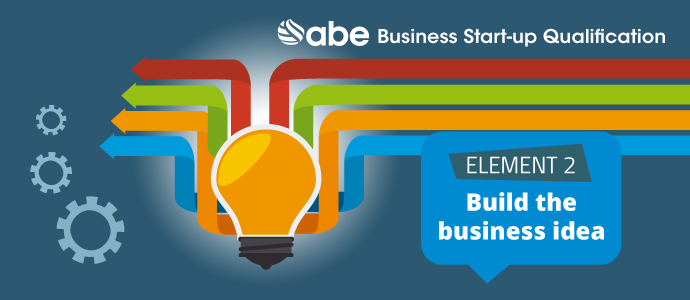
You are now fully equipped with the knowledge that you need to begin your entrepreneurial journey, and should turn your attention to building your business start up idea.
Consider who will buy your product or service, gain valuable feedback from your target market through research and take your initial thoughts from ‘just an idea’ to a unique, business concept.
How is the Business Idea Unique?
The next stage of the business start up process is identifying how your product is unique from others on the market. In detail, analyse what your product or service is, how you will sell it/they, will there need to be any additional services to go alongside the initial offering? The more in-depth the analysis of your product or service, the better.
Once you have a detailed description of your business idea, use it to identify how your product or service differs from that offered by your competition. Analyse areas where your product is the same as your competitors, seize opportunities in any areas where you know that your product is stronger and, identify your areas of weakness compared to competing products.
With a better understanding of where your product stands within the market, you can further refine your business idea to produce a concept statement. Your statement should be no longer than a few sentences and can be included in your business plan as a way of aiding potential investors in the visualisation your product.
With a solid, business idea, you will need to think about intellectual property. Patents, trademarks and copyrights are essential to a new business start up but can often be overlooked. Understanding the different types of intellectual property will enable you to:
- Protect your business ideas from competitors
- Protect your brand including its name and logo
- Protect the ‘expression of ideas’ including photographs that you might publish

Identify Potential Customers
In the article ‘Understanding Your Market for Future Development’ Yoav Farbey, Director of The Start-Up Mag, states;
“to build a product that is both desirable and viable, it is necessary that your company understands your users”.
Is your product business to business (B2B) or will it be business to consumer (B2C)? Which market segment will you target? Market segmentation allows you to target specific customers based on geographic, demographic, behavioural and psychographic information, ensuring that your product is marketed directly to the customers who’s needs best match it.
Building a customer profile is important regardless of whether you have a B2B or B2C business idea. You need to understand your ideal customer, whether it is a person or a business. Creating a customer profile enables you to analyse your customer demographics, psychographics and demographics as well as their spending habits.
Developing Unique Selling Propositions
Also known as ‘unique selling point’ or USP, unique selling propositions are the unique factors that differentiate your product from others on the market. This could be the cost, the quality or an added feature that distinguishes your product from its competition.
Primary research should be used to gain insight from potential customers as to what would make them choose your product, over your competitors.
Based on this information you can further redefine your initial business idea but, this time with the addition of a list of USP’s. It’s important to remember that with a USP, you are looking for a gap in the market. Screening your list of unique selling points against competing products ensures that you aren’t targeting an already crowded market.
The Role of Market Analysis in Planning a Start Up Business
We discussed market analysis in element one, and the information sources available to you to aid this.
In any start up business, researching the market is used to inform the overall business plan and strategy cycle. This method of planning allows you to make more confident decisions but, to benefit from this, you need to complete each stage of the process:
- Analysis
- Insight
- Planning
- Action
- Results
By following the strategy cycle model, external factors will be examined, leading to the identification of potential threats and ensuring that risk assessments are carried out. As well as threats, this planning strategy highlights external opportunities within the market that should be taken advantage of.
SWOT Analysis
A SWOT Analysis is a hugely useful tool to help with the analysis of both internal and external factors relating to a business.
Primary research can be used to assess the strengths of your business. Feedback from your target market will highlight your advantages, your USPs and the factors that encourage them to buy from you over your competitors. Weaknesses also can be identified from primary research, as well as your personal development plan.
A SWOT Analysis is an effective way of analysing the environment outside of your business. The external opportunities and threats identified while following the planning strategy cycle feed into the SWOT Analysis. Opportunities such as gaps in the market should be seized to differentiate your product from that of competitors while the early identification of threats allows for risk mitigation to minimise adverse effects.
Produce Measurable Business Objectives
Business objectives and goals are a crucial part of the planning process for your start up. Without a clear aim, you cannot know what resources and steps are needed to get there. Objectives also provide those interested in the business with a vision of what you expect to accomplish within a specific timescale.
SMART Objectives
SMART objectives ensure that the goals that you are setting are attainable.
- S – Specific
- M – Measurable
- A – Attainable
- R – Realistic
- T – Timely
An objective that is specific has a higher chance of being accomplished than a ‘general’ goal, as does an objective that is measurable, with milestones to reach. Any objective can be attainable, as long as the right steps are taken to get there, however, objectives need to be realistic and something that you are willing and able to work towards. Adding a time frame to an objective gives you the motivation to begin working on it straight away, if no deadline is set, this objective can be pushed aside and forgotten about.
Timeframes
Objectives can have different time frames, short, medium and long term.
Short-term objectives: usually have a time from of within a year and are often relate to finance; ‘Increase turnover by 5% by the end of the financial year’.
Medium-term objectives: have a timescale of between 18 months and 3/5 years’ business depending and relate to larger objectives which could rely on the short-term goals to be attainable, for example; ‘move to larger premises’ by a particular date.
Long-term goals: are aspirational and have a timescale of well over five years; this could include ‘have a business worth £2million before the owner retires’.
As a start up business entrepreneur, it may be tempting to ignore long-term objectives and focus on the short term. This gives the impression that you lack confidence in your business plan and in the business itself. Short-term objectives should be tailored so that they can help your business achieve its long-term goal. For example, a short-term objective of increasing turnover by 5% by the end of the financial year would support a long-term goal of turning over £1million within ten years.
Measure your Success
There are a number of factors that you can implement to ensure that your business start up is on track to meet its objectives.
Critical Success Factors (CSFs) are areas of activity that help the business achieve its objectives when they are effectively implemented. These factors are strongly linked to the business objectives and, act as a common focus for the whole team to ensure that they are working towards the same goals.
Key Performance Indicators (KPIs) are measurements of performance that demonstrate how efficiently a company is achieving its key objectives. You will use these indicators to not only assess your progress when it comes to accomplishing objectives, but to compare your finances and performance with competitors within your industry.
Performance Measures differ to KPIs as they offer a definitive measure of an objective rather than an indication of efficiency, as with a KPI.
Non-Financial Objectives aid in the improvement of an overall company, rather than financial objectives which focus on increased profits. Non-financial objectives are important for analysing customer service, ensuring the quality of products and services and for maintaining the company’s public image. For a business start up, these objectives are of particular importance.
Customer service based objectives ensure that the company has a focus on building and maintaining relationships with its customers, leading to a positive reputation. Quality based objectives keep a focus on manufacturing high-quality goods for the customer; high-quality products will encourage customers to return to your business again. Good PR is important for a start up business to encourage customers to use you in the first place. While it is said that there is ‘no such thing as bad publicity’, negative reviews will put potential customers off.
The Next Step
You now know all that there is to know about building and refining your business idea to turn it into a unique and exciting product that your target market needs.
You’ve got the product, now you need to market it. In Element 3 – Planning the Marketing Approach, we build a marketing plan and use the marketing mix to create a positioning strategy. Read on to continue your entrepreneurial journey or, if you’re just starting out, enrol on our ABE Level 3 Certificate in Business Start-up and get all of the knowledge and support that you need to make setting up your business simple!
For more information or to speak to one of our advisors get in contact with us today.











Leave a Reply